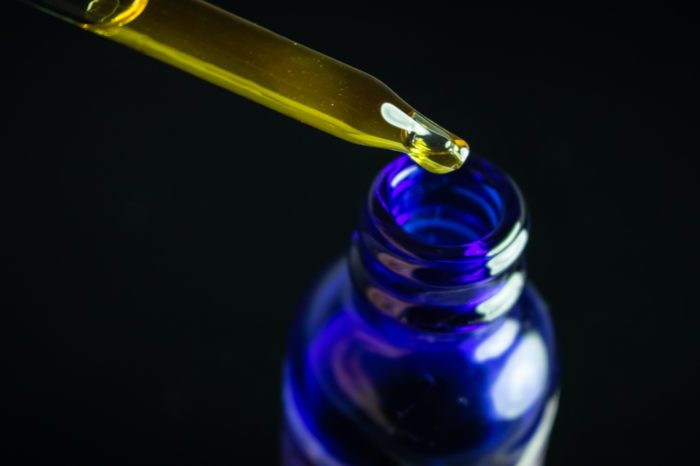How do you maximize control over dose and strain when you make a cannabis tincture at home? Try this alcohol-free recipe.
Editor’s Note: While tinctures technically refer to a concentration of herbs in alcohol, many patients want to know how to make an alcohol-free tincture while getting the same concentrated benefits. Here’s how.
One of North America’s wisest living herbalists, Rosemary Gladstar: “It is my body, my health, my balance, and my responsibility to make the right choices for myself.” Taking control of your medicine is the first step to taking back control of your health. Following this guiding mantra, ask yourself if it is time to take control of your green-leafed medicine as well. If you take cannabis tinctures for therapeutic applications, you’ll already know their power. But did you know you can maximize your control over dose and contents, including the strain and solvent, when you make your own alcohol-free cannabis tincture at home?
Originally, all cannabis tinctures were alcohol based. But if you make them at home, you get to choose the extraction technique. Again, it’s about taking control over your medicine. If you live a sober lifestyle, or if alcohol even in tincture formats isn’t an option, making your own alcohol-free cannabis tincture ensures you can still use tinctures. The following guide will cover the basics of tinctures, how to make them at home without alcohol, and the benefits of tinctures for health and wellness.

The Basics of Herbal Tinctures
At the dispensary, you’ll likely see a number of different cannabis “tinctures”. These products may be labeled as anything from concentrates, to extracts, to “drops”. Unless you look at the ingredients, you don’t know exactly what you’re buying.
According to Mountain Rose Herbs, an herbal emporium and good resource for information on herbalism: “All tinctures are extracts, but not all extracts are tinctures!” The word tincture describes a solution made with alcohol. Without alcohol, it doesn’t qualify as a true tincture. Alcohol is the substance that extracts the cannabinoids and other valuable compounds from cannabis. So, a cannabis tincture is an alcohol extraction.
Because we are talking about alcohol-free “tinctures” here, we should be clear. Technically, you can’t label any extractions made without alcohol as official tinctures. There are many other oils, vinegars, and solvents capable of pulling the cannabinoids out of cannabis. For the sake of this article, we’ll continue to call it a tincture to avoid any confusion – in this case a tincture and an extraction serve the same purpose!
How to Make an Alcohol-Free Extraction
The beauty of making your own alcohol-free extraction is the ability to customize it to your needs. Choose different strains and potencies based on what you are trying to treat. Daily chronic pain? You may lean towards strains with higher THC ratios. If you have anxiety and stress, a CBD focused strain might be the best option.
Because you are in charge of dosing, add more or less cannabis to this recipe to suit your needs. You’ll note there are no specific quantities below because it’s entirely up to you. Once ready, be sure to slowly and carefully test the potency. A little goes a long way until you know how strong it is. Always remember: Start low and go slow.
What You’ll Need
- Cannabis (trim, sugar leaves, buds, or hash)
- Food-safe vegetable glycerin
- Mason jar
- Cheesecloth or fine kitchen sieve
Directions for Alcohol-Free Cannabis Tincture
- Roughly grind the cannabis and put into the oven to decarboxylate it for 40 minutes. Instructions for decarbing your cannabis here.
- Add all cannabis into the mason jar, leaving at least a two inches of space at the top.
- Pour over the food-safe vegetable glycerin to cover the cannabis by one to two inches.
- Seal the jar, and place in a cool dark environment for 60 days.
- Every few days, gently turn the glass jar over to agitate the contents.
- After 60 days, strain the organic plant material out.
- Store in a cool dry place. Slowly experiment with dose to determine potency.
Most recipes for alcohol-free “tinctures” suggest food-safe vegetable glycerin, but you also have other options if this isn’t available. Any natural food-safe carrier oil can work including olive oil, grape seed, and liquid coconut oil.

What Are the Benefits of a Tincture (Alcohol-Free or Not)?
Most people take tinctures orally — a few drops placed under the tongue or the back of the throat that’s then allowed to absorb. You can also make edibles or topicals with tinctures. Tinctures are a highly concentrated extract of the compounds found in the original plant material.
If we are explicitly talking about cannabis tinctures, these are a valuable way to receive the therapeutic properties of the plant. Once you determine the potency of your concoction, a tincture is easy to dose. It’s simple to measure out and then adjust if needed. For example, maybe you found five drops in the morning provides the perfect day time relief and ten drops at bedtime for eight hours of rest. Not enough? Add a few drops! Too much? Reduce. It’s as easy as that, and much more consistent than an edible or a joint.
With the discretion, consistency, and control a tincture provides a patient they are often the format of choice. From people managing pain (read Mel’s story) to people using CBD tinctures for mood relief (read Allison’s story), tinctures are an effective method to consume cannabis therapeutically and avoid the hazards of smoking. Cannabis tinctures are easily incorporated into a holistic approach to medicine. Because they are easy to make at home, they give you control over what goes into your body.






Vickie Lee Fenster
Good information…thank from Alaska
Jon Gray
I’m just curious what to use as the solvent to extract maximum cannabanoids from the flower that we use?